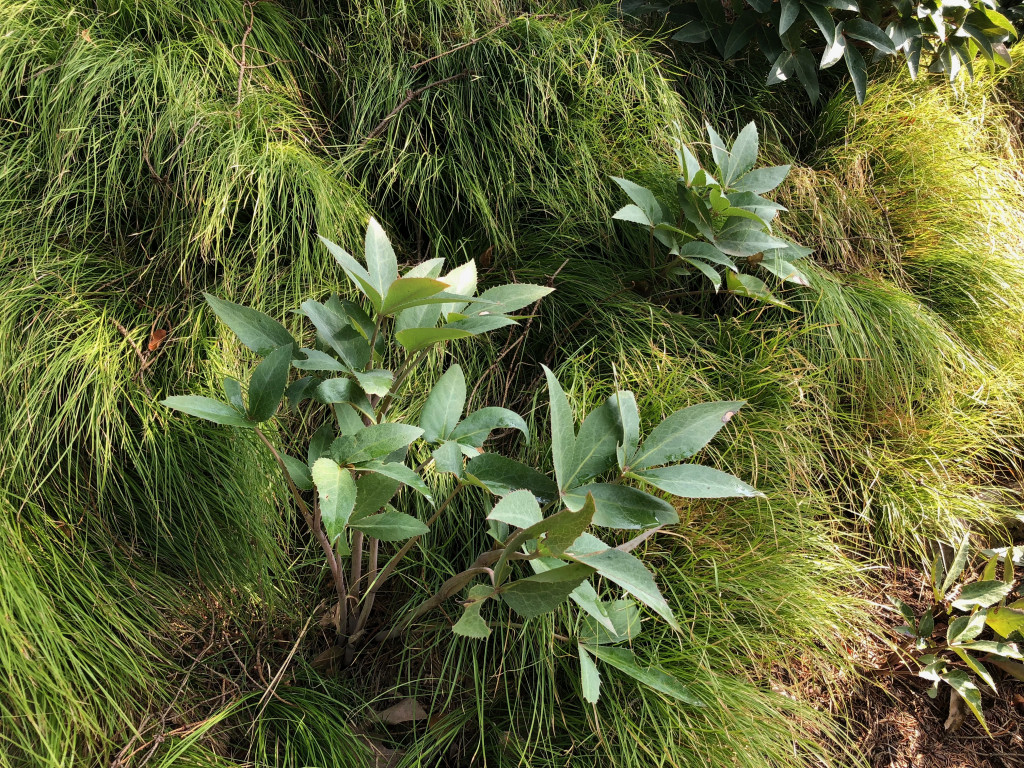I’m not sure whether it’s the demands of design work, or the demands of my own (too-big) garden, or sheer curiosity, but I’m forever pondering questions of how much work is involved in the growing of any particular garden plant – how much grooming, or maintenance, or long-term management is required to keep it looking good.
Just as a ‘for instance’, I have for many years defaulted to using deciduous grasses over evergreen ones in my design work, primarily because they’re much easier in both maintenance and management. Think about it for a second. Deciduous grasses require absolutely no ‘grooming’. All they ask is to get cut back hard at a single time in the year – usually late winter or early spring. Nothing else. Their foliage is then entirely renewed every year, and they carry no dead-leaves whatsoever throughout spring, summer and early autumn. Evergreen grasses, on the other hand, always carry a proportion of dead leaves after about the second growing season, and very few of them are tolerant of begin regularly shorn back. Flowerheads have to be individually removed, and if the dead leaves become too unsightly, there’s nothing for it but to ‘comb’ through the plant with a gloved hand to remove the worst of them.

Now I admit to have created something of an exaggeratedly false dichotomy for the purposes of my argument, but you can see where I’m coming from.
A few years back I was designing a garden for a regional hospital, and given the resource-starved reality for such institutions, started to explore a self-created category of plants that are evergreen, but renew themselves from the base on a regular basis, that might be more or less ‘self-grooming’. I was thinking of plants like the caulescent hellebores (those with a stem) like H. argutifolius and H. lividus. These flower in winter on stems produced the previous spring, and as they flower and set seed, they invariably begin to recline on the ground, while the new crop of stems emerges above the old, carrying fresh new foliage throughout spring, summer and autumn, then producing flowers for the winter. The old stems, post-flowering, gradually just wither away, and while the plants always look better with the old stems removed, it’s not necessary to remove them, and as long as neighbouring plants reduce the visibility of this shaggy petticoat, you’d barely know it was there. The same goes for several of the Euphorbias, including E. rigida and E. myrsinites. You could (potentially), and in certain wild-is conditions, consider these plants pretty much self-grooming.

The other great advantage of plants with this cyclical form of growth is that they don’t slowly get taller, which is one of the most challenging aspects of long-term garden management – how to keep things in balance while shrubs gradually get bulkier with each passing year. With shrubs, you’re forever wondering if you should you sheer them over annually to maintain a certain height, or leave them be, then cut them hard every few years? When you’re designing for others, you rarely know what kind of maintenance they’re going to get, if any at all.

My forced ‘no grooming’ or ‘low grooming’ category of plants also contained the various nandinas. I’ve made my deep hatred of Nandina domestica ‘Nana’ clear on these pages, but I’m not so dismissive of some of the newer ones, nor of the oldest of them all, the straight Nandina domestica, which, depending on placement or usage, can be a very fine plant indeed. I’m giving the recent release Nandina filamentosa a tentative green light (see the lacy foliage in the main image under the heading above), and I’m nervously enthusiastic about Nandina ‘Lemon Lime’. I was temporarily enthusiastic about N. ‘Moonbay’, but have since decided that it’s excellent height and foliage is just too dense and congested for the inherent laciness of the leaves to read with any clarity. Nevertheless, it falls perfectly into my category of ‘no groom’ plants.
What plants do you find give you the most bang for your buck – that give the most while demanding the least in the way of grooming or maintenance?
At last some gentle rain which means for once I am not out in the garden.
A plant that I just love that ticks the boxes for colour, form and low maintenance is the orange sedge, Carex testacea. Once a year grab a handful of the very fine and incredibly long seed stalks which easily pull away. After a few years if plants are looking tired, they will likely have self seeded enough (but not too much) to abandon the older plants. I bless them every year when cutting our dozens of miscanthus and pennesetum to the ground.
As you say, simply replacing them with self-sown neighbours is the only realistic way to deal with them. As long as you’re prepared to do that, they’re very low maintenance indeed
I love cane begonias in my garden.. Started growing them as a quick fix to hide a new pailing fence a neighbour installed. Very easy to strike and establish and as a background plant they give so much joy with their splashed, spotted and variegated leaves and different shades of green with additional pleasure in their lovely delicate flowers over a long period. I planted them in groups of the same variety.
I’m so with you! If I lived somewhere frost-free, I’d be depending on them heavily. In fact, there’s something to be said about the low-maintenance demands of many things that are cane-growers, in that they tend to get to a certain height, and then maintain that in a way that a peripherally-growing shrub doesn’t
On the top of my list I would put Anemanthele lessoniana. Looks fabulous all year round and maintains it shape and colour wonderfully even in dry weather.
I agree with this. As long as you treat them like Anne’s Carex
japanese anemones__months of flowers followed by just one cutting back a year